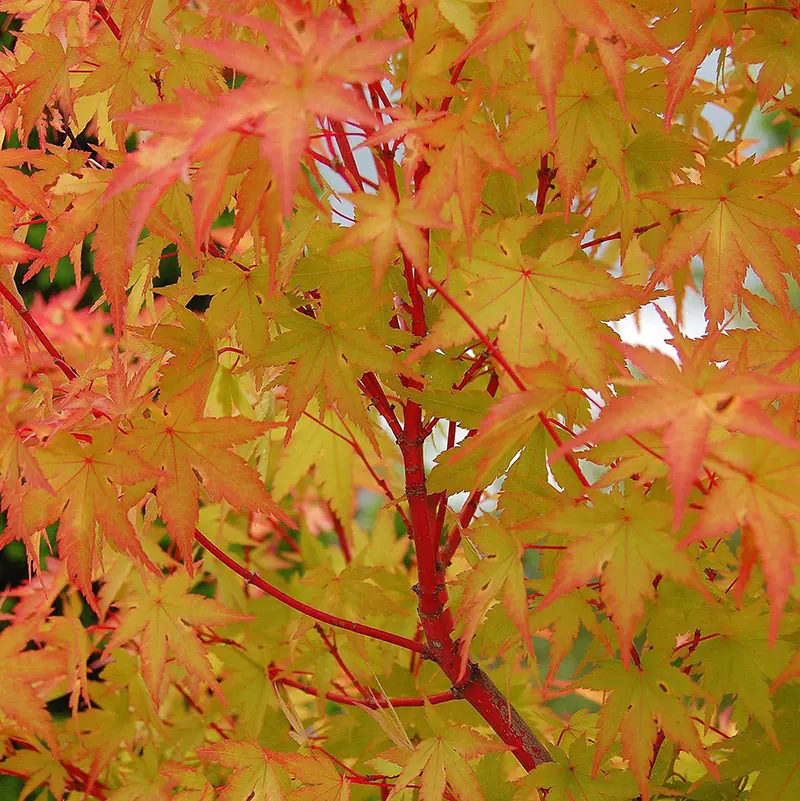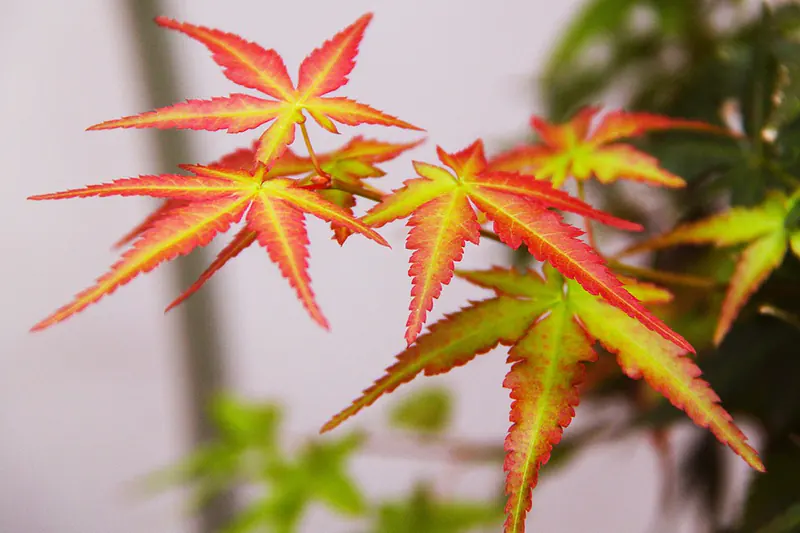Coral Bark Japanese Maple
The coral bark Japanese maple is a great tree to begin growing. The species takes well to many living conditions and can survive inside and outside. With such versatility, it’s hard to know which options are best for the tree, especially if you’re a newcomer to growing bonsai.
While guiding you through the needs of this bonsai, we’ll also explain several considerations and questions that will benefit you while growing the coral bark maple.
Here's what you'll find in our Coral bark
Japanese maple bonsai species guide:
Quick Coral Bark Japanese Maple Bonsai Care Sheet
Here’s a quick overview of the information you’ll find within the article. This short table only covers the basics; please see the rest of the article for a full guide.
Recommended soil | An akadama mixture with added lava rocks and pumice. |
Watering | Once a day. |
Potting season | Every second year. |
Shaping and pruning season | Every second year, during autumn. |
Light | Full sunlight, partial shade. |
Fertilizing | Solid organic fertilizer. Low nitrogen content. |
Propagation methods | Seeds, cuttings, and air layering. |
Pests and diseases | Aphids, verticillium wilt, and other infections. |
How To Care For A Coral Bark Japanese Maple Bonsai
In this section, we’ll cover all the details that were left out in the quick guide. We also cover alternatives and solutions to issues you may encounter when handling the requirements.
Best Soil
Overall, the best soil choice for the coral bark Japanese maple is an akadama mix with pumice and lava rocks added to it. This option will retain more moisture and nutrients while still draining and preventing damage to your tree’s roots.
Alternatively, a regular soil mix will work well when growing this bonsai. This option is easier to buy and replace during the repotting season. However, aside from draining well, there are no added benefits.
Watering
The coral bark Japanese maple is a tricky tree to water. Often, you’ll need to water the tree once a day. However, at times as the climate and environment change, you’ll increase this frequency. Without careful attention, it’s easy to overwater this bonsai.
Repotting
Repot your coral bark tree every second year. This frequency won’t change regardless of the bonsai’s age as the species rapidly regrows its roots. Depending on how much you trim the roots down, you may need a larger pot every few years.
We recommend you wash the container thoroughly to prevent any infection in the roots during this time. When trimming roots, use a thin stick such as a pencil or chopstick to untangle them and get clean cuts.
Shaping And Pruning
You can trim most of your coral bark Japanese maple anytime during the year. However, you should only trim these smaller parts every second year to prevent irregularities with their growth. Larger branches should be trimmed during autumn and have cut paste applied to prevent any infection.
Location And Sunlight
The coral bark maple requires a full day of sunlight where possible. However, the bonsai can survive with partial sunlight exposure but will grow less. The tree should be kept out of the summer afternoon sunlight, as too much exposure will affect the foliage’s health.
During winter, the tree will enter a state of hibernation if kept outdoors in a cold environment. When the temperature reaches near freezing, the tree should be sheltered or moved indoors.
Fertilizing
Use a solid organic fertilizer as added nutrients while growing your coral bark Japanese bonsai. This option should have a low nitrogen content, as too much of this element will affect the growth rate of your bonsai’s leaves. Add a liquid fertilizer once a week for a stronger dose of nutrients.
Propagation Methods
You can grow a new coral bark Japanese maple with seeds, cuttings, or air layering. We advise you to use these methods during autumn, as your new bonsai will grow best during that season.
Pests And Diseases
Verticillium wilt and other infections can kill your coral bark bonsai if you don’t catch it fast enough. The infection has no cure but can be managed. Cut away any afflicted area, use fertilizer to give your bonsai a nutrients boost, and keep it quarantined away from other plants. With time and care, your bonsai should eventually heal.
Aphids are the most common pest that attacks your coral bark Japanese maple bonsai. These tiny insects tend to eat sap and other nutrients from your tree, damaging its health. Frequently misting your bonsai keeps the pests away, while regular insecticide will kill an infestation.

Considerations For Growing An Indoor Coral Bark Japanese Maple
When growing a bonsai indoors, you’ll need to pay careful attention to certain tree needs. Here we look at handling winter indoors and where to keep your tree for optimal growth.
Placement
Keep your coral bark bonsai near a sun-receiving window. Due to the damage, a summer afternoon’s sun can do, morning sunlight is preferable if you have the choice. Opening a window during the day will help the bonsai grow as well.
Winter
We advise you to regulate the room temperature where you keep your coral bark bonsai during winter. If the tree gets too cold, it will enter a hibernation state and lose its leaves. Additionally, temperatures below freezing can harm the bonsai if kept too long.
Common Issues When Caring For A Coral Bark Japanese Maple Bonsai
When caring for a coral bark Japanese maple bonsai, you’re sure to have a few complications. Watering and infections are the most important aspects to worry about.
Overwatering
The coral bark maple is a thirsty tree that will occupy a part of your time each day with watering. However, during warmer seasons and less humid air, the tree will require water more than once each day. It’s easy to get into a habit that results in overwatering quickly.
Remember to touch the soil, pressing your finger in deeply as you feel for moisture. We advise you to do this check every so often when caring for your maple bonsai.
Infections
Your coral bark bonsai is prone to infections. Aside from verticillium wilt, your tree can contract an infection from cutting large branches or damaged roots. Always use cut paste when trimming large branches and clean your bonsai’s roots thoroughly when repotting it every two years.

FAQs About Coral Bark Japanese Maple Bonsai
While the guide may not have answered all your questions, here are several commonly asked items by other bonsai growers. We explain why the Japanese maple makes a great bonsai, the tree’s unique bark, and whether the tree can survive in full sunlight.
The Japanese maple species is a great option to turn into bonsai trees. When growing a coral bark as a bonsai, you’ll easily find a suitable location to keep it. Additionally, shaping and pruning the tree as it grows is a simple task.
The coral bark Japanese maple has a bright and intense red-colored bark. This distinct coloring makes the tree an attractive option to grow. The coloring won’t affect any tree’s needs, but a watchful eye is still advised.
The coral barkJapanese maple’s bark stays red as it grows through the year. While hot temperatures or extreme sunlight may change the coloring slightly, your tree’s bark will remain red.
Full sunlight with partial shade is the recommended amount of light for the coral bark Japanese maple. However, the tree can survive with only a few hours of sunlight per day. In warm climates, the summer afternoon sun can harm the health of your leaves.







